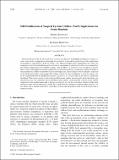Self-Stratification of Tropical Cyclone Outflow. Part I: Implications for Storm Structure
Author(s)
Emanuel, Kerry Andrew; Rotunno, Richard
DownloadEmanuel-2011-Self-Stratification.pdf (1.219Mb)
PUBLISHER_POLICY
Publisher Policy
Article is made available in accordance with the publisher's policy and may be subject to US copyright law. Please refer to the publisher's site for terms of use.
Terms of use
Metadata
Show full item recordAbstract
Extant theoretical work on the steady-state structure and intensity of idealized axisymmetric tropical cyclones relies on the assumption that isentropic surfaces in the storm outflow match those of the unperturbed environment at large distances from the storm’s core. These isentropic surfaces generally lie just above the tropopause, where the vertical temperature structure is approximately isothermal, so it has been assumed that the absolute temperature of the outflow is nearly constant. Here it is shown that this assumption is not justified, at least when applied to storms simulated by a convection-resolving axisymmetric numerical model in which much of the outflow occurs below the ambient tropopause and develops its own stratification, unrelated to that of the unperturbed environment. The authors propose that this stratification is set in the storm’s core by the requirement that the Richardson number remain near its critical value for the onset of small-scale turbulence. This ansatz is tested by calculating the Richardson number in numerically simulated storms, and then showing that the assumption of constant Richardson number determines the variation of the outflow temperature with angular momentum or entropy and thereby sets the low-level radial structure of the storm outside its radius of maximum surface winds. Part II will show that allowing the outflow temperature to vary also allows one to discard an empirical factor that was introduced in previous work on the intensification of tropical cyclones.
Date issued
2011-10Department
Massachusetts Institute of Technology. Department of Earth, Atmospheric, and Planetary Sciences; Massachusetts Institute of Technology. Program in Atmospheres, Oceans, and ClimateJournal
Journal of Atmospheric Sciences
Publisher
American Meteorological Society
Citation
Emanuel, Kerry, and Richard Rotunno. “Self-Stratification of Tropical Cyclone Outflow. Part I: Implications for Storm Structure.” Journal of the Atmospheric Sciences 68.10 (2011): 2236–2249. Web. © 2011 American Meteorological Society.
Version: Final published version
ISSN
0022-4928
1520-0469